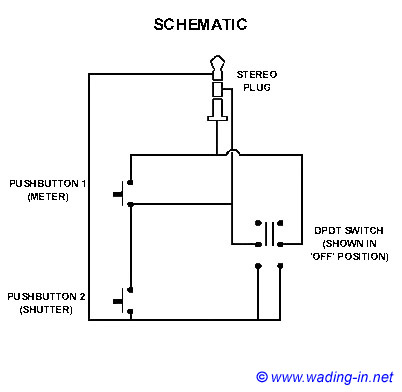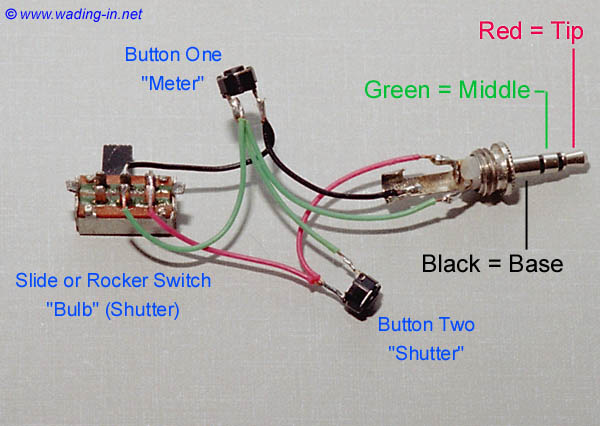|
Making
your own RS-60E3 Remote Control for Canon EOS cameras
|
||
 |
Welcome to, ashamedly, the most popular page on my website. I'm not really sure why, but I guess people like these do-it-yourself projects. Promise me you'll go look at pretty pictures after this, okay?
|
Why? (I mean, why build your own remote.) No real good reason. It's easy, and allows for customization. But if you need it to be justified, this page isn't for you. The Canon RS-60E3 isn't an expensive unit, but you can make one even cheaper, if you don't mind the time and effort. How it works: You will have three 'controls'. Two momentary pushbuttons, and by this I mean like a videogame button, not a 'push-on/push-off' like a ballpoint pen. For short exposures, you would press one button to activate the meter and AF, just like a 'half-press' of the shutter release on the camera, and BOTH buttons to release the shutter. You will also have a slide or rocker switch strictly for Bulb exposures, to open the shutter and go away if you want. It does not operate the meter, it simply locks open the shutter. |
List
of Materials:
|
|
The photo at top, and to the right, is of my own unit, which I custom-made since I'm good with plastic. This allowed for two things: The first, I was able to make a shape comfortable for my hand, that I could tell, even blindfolded, how to trip the shutter; The second, I needed a rocker switch to fit the housing, and nobody made one, so I created one from a slide switch. I don't necessarily recommend this. It can take a bit of work. I'm happy with the results, but I also enjoyed the project. Don't tackle it unless you enjoy the challenge. But if you do, there's instructions further down. You'll notice two things: The rocker switch sits flush in the housing when it's 'Off', making it easy to tell by feel that it isn't switched on before I plug it in (thus no wasted shots). Plus it's harder to trip accidentally. The second thing is that the wire exits the housing at a distinct angle. This was on purpose - I know top from bottom this way, and it rolls up much neater. Just a couple tricks from doing this once previously. |
 |
|
The cameras that take the RS-60E3 provide all the power and work very simply. The jack on the camera body is a standard 2.5mm stereo, so a 2.5mm stereo plug (male) is a perfect fit. Close the base and middle contacts of the stereo plug to meter, and all three to close the shutter. Closing the base and tip alone will accomplish nothing, and neither will closing the middle and tip. Your materials are a matter of preference. I used microswitches for the momentary pushbuttons, for the low profile and the tactile 'clicks' they provide. Also, some designs suggest toggles for the big 'Bulb' switch, but I found that you want something smaller and less likely to snag on things, and that is also readily apparent that it is 'Off'. If you don't want to make your own like I did, I suggest a marked slide switch or a marked rocker switch. BUT, either of these have to be DPDT, because you have three leads to close at once, and won't be able to wire the assembly correctly if the switch isn't DPDT. |
 |
|
For those of you who don't like schematic layouts, I did a wiring example photo. Naturally there will be a lot more wire between the plug and controls, but this shows you the layout. My photo isn't perfectly clear in one respect - on the "Bulb" switch, the red wire goes across both contacts on the one end, while the black and green wires only connect to the leads on their sides (top and bottom respectively, in this photo). There is no connection between green and black on the switch leads. |
 |
|
A word about your materials: Don't feel obligated to use what I use, if there's something you like better. Any momentary pushbutton will work, and microswitches are very sensitive to heat. If you use them, always use a heatsink between the button and the lead you're soldering, and solder very quickly. Best to apply a little flux to wire and lead and hold them together, then get a small drop of hot solder on the tip of the soldering iron and merely touch it to the lead. The flux will draw the solder onto the wire and lead and allow it to cool very quickly, so there's little chance of damaging the microswitch. If you hold the iron against the lead for any length of time, you're liable to ruin it. And always check it for continuity every step of the way — it's a real pain to disassemble everything if one item doesn't work. When I first wrote this up, I had not yet found any 'two-position' pushbuttons like Canon uses on both their cameras and the RS-60E3 remote — that is, a half-press to meter, and a full-press to trip the shutter. Readers have clued me in to some sources since (like Mouser Electronics), but I haven't tried the same project with any of these switches. So we're sticking to the original design using two pushbuttons, and one becomes the 'half-press' to meter, and both are the 'full-press' to trip the shutter. As for slide or rocker switches, it's important to use DPDT. These are two-sided designs, so that one side is isolated from the other, and the only way to close the three leads from the camera at once. Any other method, you're liable to trip the shutter when you only intended to meter, and the remote won't work correctly. So be careful about this and wire it exactly as shown, and note the caption above where I clarified something not distinct in the photo. First off, handle the housing you're going to use before beginning. Figure out where you want the buttons for easy use. For me, I made my own housing out of sheet polystyrene, and placed the meter button on the top, under my thumb, and the shutter button on the underside under my index finger. Very easy to press one, then both buttons. From experience, I have to say that it's much easier on you if you lay out the project so you can tell which button is which by feel, and whether the Bulb switch is on or off. This is especially handy when doing long exposures in the dark, such as the night sky. One clever reader used an old computer mouse for his housing, which already has the microswitches in place. I wish I'd thought of that... I would place your switches in the housing before soldering them, if you can get away with it. If not, allow plenty of slack wire. By looking at the schematic, you'll notice that each lead from the 2.5mm plug splits in two directions, for the two ways of releasing the shutter, and how you accomplish this is up to you. How much wire to use between remote housing and plug? That's a matter of personal preference. Remember that you have to coil it all up neatly in your camera bag, plus have a decent working length for whatever you might use it for (unless you use an extension - more just below). Mine has slightly more than a meter, and I have a Velcro strap that holds it all together neatly. At my normal working height on a tripod, it doesn't touch the ground if I let it drop. But you might also want to be able to grab it easily in the dark, so you may want it very short, or able to clip onto itself near the jack, or someplace onto the camera. Now's the time to think about it. |
 |
And before you pack it all together in your nice, neat little package, TEST IT! Test all connections, and make sure it works on the camera for both methods of opening the shutter. It's really annoying to crack open your housing to replace a part or resolder a connection. And try to keep this in mind all through assembly — there's a reason there are no photos of the interior of my remote: A solder joint failed sometime during assembly, and had to be resoldered after I had already glued the microswitches in place. I ended up having to install jumper wires, and the soldering iron was too large to use in the tight confines of the housing, so there's a mess of wires in mine, as well as some melted areas. The image would have been of no use to anyone wanting to see how to build their own, and might well have been very discouraging ;-). So that's it, and I hope it's clear enough, but if not, drop me a line and I'll explain it differently or in better detail. Also, let me know if there's anything I misstated or didn't illustrate well. A bonus from having done this before: I rigged mine slightly differently. Instead of a 2.5mm micro stereo plug, I used a 3.5mm mini stereo plug. Why? Because I made a small right-angle adapter which puts less strain on the plug and camera, and now I can extend the cord indefinitely with any extension cord suitable for the more-common 3.5mm connections, used on all portable stereos. Plus, I can also rig in anything else that I might make. So, I bought a 2.5mm micro male plug from Radio Shack, a right-angle wire-it-yourself version. 3.5mm female sockets in cord form were almost impossible to find when I did this (I've since found them at Radio Shack, which seems very sporadic about what components it decides to keep in stock). So I bought a headphone volume control addition that Radio Shack sells, and cannibalized it for the 3.5mm inline socket, wiring it to the 2.5mm right-angle male plug to go into the camera (about 5-6 cms in wire length) . Instead of the plug sticking straight out of the camera with the weight of the cord pulling it downwards, it sets much closer and has more stability, plus it won't pull out with the weight of the cord when you turn the camera for a vertical composition. Later on I purchased a Canon TC-80N3 Remote, which is rather expensive but contains a microcomputer that allows for interval frames and programmed time exposures and all that hoohah. The connection, however, is Canon's N3 rather than the simple E3 shown here, a dedicated fancy plug that nevertheless has the same three contacts. I lopped off the plug end and wired in a 3.5mm mini male connector on one side, and a female on the other, corresponding to the adapter I show here from this project. Which means I can use the TC-80N3 on my EOS 3, 300D, and Elan II & 7 bodies just by switching the adapter. Both adapters, by the way, are taped together facing in opposite directions so they not only are right at hand, I know which one I'm using by feel. |
 |
Now originally, I invited people to write me with pics of their designs, and I'd feature them on this page. This was bad on my part, because I'm pretty slow with e-mail replies sometimes and haven't updated this page in far too long. To those several people who wrote me, I apologize. But it's indeed good to hear this has worked for some!
Also, I originally had a very detailed section here on making your own housing from sheet polystyrene, like the photos at top. Nobody wanted to tackle this, and in all seriousness, it's easier to find a simple housing. So I simply pulled that section now.
Anyway, good luck, and I hope you have fun with it!
- Al.
 What's this? What's this? |
 |